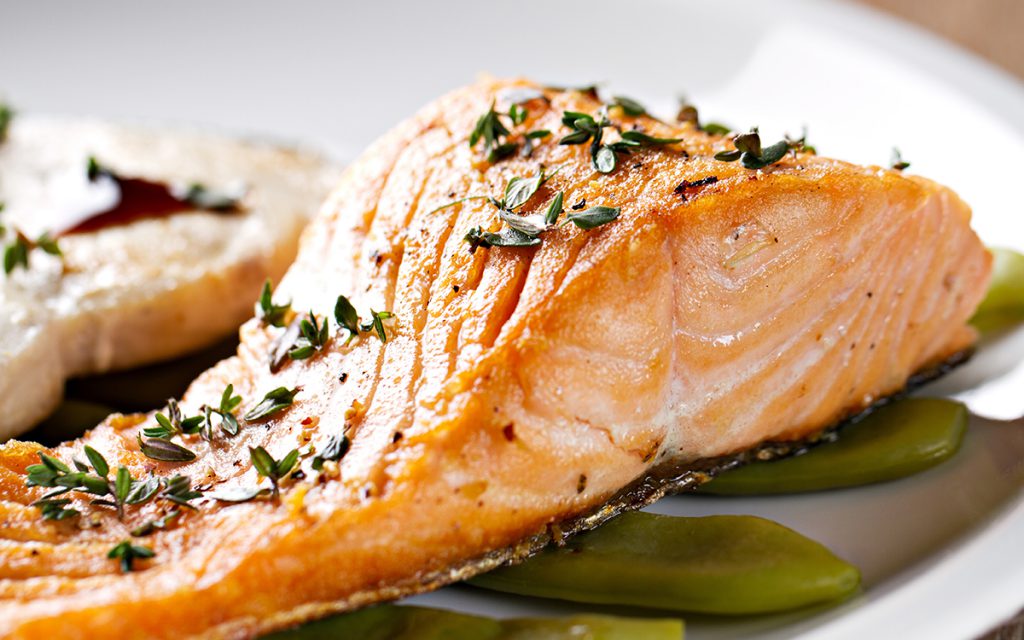In the 90s, fat was considered the culprit for adding inches to your waistline and raising cholesterol, which made low-fat diets and marketing all the rage [3]. Grocery store shelves were quickly stocked with items claiming to be “low-fat” or “fat-free” on their packaging, convincing consumers that they’d contribute to a “healthier” diet.
The truth is, in order to maintain an enjoyable texture and taste in low-fat food products, food manufacturers actually replaced fat with hydrogenated vegetable oils and sugar [2].
These low-fat products that were often considered “healthier” options at the time, were actually high in carbohydrates, artificial trans-fats, and often had the same calorie count as the original full-fat product [2].
Current research demonstrates just how crucial daily fat consumption is to a well-balanced diet and long-term health [5].
Fat produces hormones, helps our bodies absorb vitamins, provides energy, and helps build new cells. It plays a vital role in the absorption of vitamins A, D, E, and K while also helping to regulate body temperature and create a feeling of satiety [4,9].
In fact, it is now evident that incorporating the right sources of healthy fats on a daily basis can promote a healthy weight and aid in weight loss.
At the same time, with the rise of high-fat diets as a method for weight los, e.g. the ketogenic diet, it is essential to understand that not all fats are created equal [2].
In other words, you can’t up your fat intake with just any type of fat and expect results. In fact, consuming too many of the wrong fats can be detrimental to your health.
What types of fats are considered healthy?
Fats can be broken down into four types: saturated fats, monounsaturated fats, polyunsaturated fats, and trans fats. The majority of fat in our diet should come from monounsaturated or polyunsaturated sources. These are considered the “good” or “healthy” fats known to lower the risk of heart disease and stroke.
Looking to improve your diet? Get a personalized nutrition regimen with Mealplan.

Monounsaturated Fats
Healthy monounsaturated fats include nuts, seeds, and avocados, as well as plant-based cooking oils (olive, avocado). Monounsaturated fats can reduce LDL (bad cholesterol) and increase HDL (good cholesterol) [4]. A 2016 study demonstrated that eating just 1/2 to 1 1/2 avocados (rich in monounsaturated fats) each day can reduce the levels of bad LDL cholesterol [6].

Polyunsaturated Fats
Mind your omegas! While omega fatty acids are essential to a healthy diet, there are major differences between them.
Omega-3 fatty acids are a type of essential polyunsaturated fat with a number of health benefits:
They decrease inflammation in the body.
Lower the risk of heart disease.
Promote healthy brain function [5].
Fish including salmon, halibut, and tuna are rich sources of these omega-3 fatty acids. Avocados and dark green leafy vegetables including kale, spinach, and collards are also excellent sources of omega-3s.
Omega-6 fatty acids are another type of essential polyunsaturated fatty acid found in plant-based oils including grapeseed oil, nuts, flax seeds, and pumpkin seeds, which all play a key role in producing energy [7].
While omega-3 and omega 6-fatty acids are both essential to our health, scientists have considered omega-6s as pro-inflammatory, versus omega-3s as anti-inflammatory [7].
There are certain vegetable oils that are very high in omega-6 fatty acids that may contribute to whole-body inflammation when consumed in large amounts. Seed and vegetable oils that have been overly processed should be avoided, including canola oil, corn, sunflower oil, soybean oil, palm oil, and peanut oil.
Researchers recommend optimizing the ratio of omega-6 fatty acids to omega-3s (between 4:1 to 1:4) by eating plenty of omega-3 rich foods, while minimizing vegetable oils/processed foods high in omega 6s. This is key to minimizing whole-body inflammation [7].

Saturated Fats
When it comes to the different types of saturated fats, there is a grey area between what is considered healthy and what is considered unhealthy.
Common sources of saturated fat include red meat, dairy products, coconut oil, and many commercially prepared baked goods. If consumed in moderation, saturated fat coming from grass-fed beef and coconut oil is a great addition to a healthy diet.
The real saturated fats to avoid are those typically found in a number of overly processed, carb-heavy desserts including store-bought cakes, cookies, and pastries as well as “fast foods” including burgers, fries, pizza, and chips.
Additionally, high fat dairy-foods including cheese and whole-milk ice cream should be limited to moderate consumption.
The U.S Department of Agriculture (USDA) suggests keeping saturated fat intake under approximately 10% of calories per day, and replacing the rest with monounsaturated and polyunsaturated fats, as opposed to carbohydrates [2].

Trans Fats
There are two types of trans fats: natural and artificial. Naturally-occurring trans fats are produced in the gut of some animals, therefore, these fats can be found in very small amounts in certain animal products (e.g., milk and meat products).
Artificial trans fats, on the other hand, are created in an industrial process that adds hydrogen to liquid vegetable oils for solidification.
Industrial-made trans fats are the real culprit for the health risks associated with fat consumption. They are a by-product of a process called hydrogenation, which is used to turn healthy oils into solids to prolong shelf-life and prevent them from becoming rancid [1].
Consuming trans fats can cause whole-body inflammation leading to various health conditions, including diabetes and cardiovascular disease.
These artificial fats are mainly found in fried foods, solid margarines, and vegetable shortening, as well as commercially baked cookies and pastries.
What makes trans fats so detrimental to health? Foods high in trans fats increase the amount of harmful cholesterol (LDL) in our bloodstream, reduce the amount of beneficial cholesterol (HDL), and contribute to insulin resistance, which increases the risk for type 2 diabetes.
Both observational and clinical studies have demonstrated an increased risk of heart disease with artificial trans fat consumption [8]. The best way to avoid trans fats is to always check the ingredient list before purchasing packaged foods, as foods that contain hydrogenated or partially hydrogenated oils will contain trans fats.
Overall, the key to incorporating healthy fat into your diet is to understand the difference between the types of fats and what sources they come from.
Prepackaged, processed foods are more likely to contain unhealthy trans fats while whole, unprocessed foods are more likely to contain good fats.
Keeping a balance of quality fat is key to nourishing the body for optimal health.
How to Incorporate Fat Into Your Diet
Consume more monounsaturated and polyunsaturated fats (fish, nuts, seeds, avocado).
Limit saturated fats (baked goods, red meat, cheese).
Avoid trans fats (margarines, vegetable shortenings, fried foods).
References
- Ascherio, A., Katan, M. B., Zock, P. L., Stampfer, M. J., & Willett, W. C. (1999). Trans fatty acids and coronary heart disease. New England Journal of Medicine, 340, 1994-1998.
- Lenighan, Y. M., McNulty, B. A., & Roche, H. M. (2019). Dietary fat composition: replacement of saturated fatty acids with PUFA as a public health strategy, with an emphasis on α-linolenic acid. Proceedings of the Nutrition Society, 1-12.
- Liu, A. G., Ford, N. A., Hu, F. B., Zelman, K. M., Mozaffarian, D., & Kris-Etherton, P. M. (2017). A healthy approach to dietary fats: understanding the science and taking action to reduce consumer confusion. Nutrition journal, 16(1), 53.
- Mashek, D. G., & Wu, C. (2015). MUFAs. Advances in Nutrition, 6(3), 276-277.
- Molfino, A., Gioia, G., Fanelli, F., & Muscaritoli, M. (2014). The role for dietary omega-3 fatty acids supplementation in older adults. Nutrients, 6(10), 4058-4072.
- Peou, S., Milliard-Hasting, B., & Shah, S. A. (2016). Impact of avocado-enriched diets on plasma lipoproteins: A meta-analysis. Journal of clinical lipidology, 10(1), 161-171.
- Simopoulos, A. P. (2006). Evolutionary aspects of diet, the omega-6/omega-3 ratio and genetic variation: nutritional implications for chronic diseases. Biomedicine & pharmacotherapy, 60(9), 502-507.
- Sun, Qi, et al. “A prospective study of trans fatty acids in erythrocytes and risk of coronary heart disease.” Circulation115.14 (2007): 1858-1865.
- USDA. Dietary Guidelines for Americans 2015-2020. 8th edition. Office of Disease Prevention and Health Promotion. https://health.gov/dietaryguidelines/2015/guidelines/


